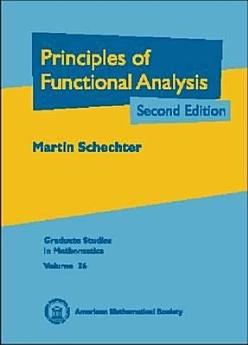Principles of Functional Analysis
វិច្ឆិកា 2001 · American Mathematical Soc.
សៀវភៅអេឡិចត្រូនិច
425
ទំព័រ
reportការវាយតម្លៃ និងមតិវាយតម្លៃមិនត្រូវបានផ្ទៀងផ្ទាត់ទេ ស្វែងយល់បន្ថែម
អំពីសៀវភៅអេឡិចត្រូនិកនេះ
This excellent book provides an elegant introduction to functional analysis ... carefully selected problems ... This is a nicely written book of great value for stimulating active work by students. It can be strongly recommended as an undergraduate or graduate text, or as a comprehensive book for self-study. --European Mathematical Society Newsletter Functional analysis plays a crucial role in the applied sciences as well as in mathematics. It is a beautiful subject that can be motivated and studied for its own sake. In keeping with this basic philosophy, the author has made this introductory text accessible to a wide spectrum of students, including beginning-level graduates and advanced undergraduates. The exposition is inviting, following threads of ideas, describing each as fully as possible, before moving on to a new topic. Supporting material is introduced as appropriate, and only to the degree needed. Some topics are treated more than once, according to the different contexts in which they arise. The prerequisites are minimal, requiring little more than advanced calculus and no measure theory. The text focuses on normed vector spaces and their important examples, Banach spaces and Hilbert spaces. The author also includes topics not usually found in texts on the subject. This Second Edition incorporates many new developments while not overshadowing the book's original flavor. Areas in the book that demonstrate its unique character have been strengthened. In particular, new material concerning Fredholm and semi-Fredholm operators is introduced, requiring minimal effort as the necessary machinery was already in place. Several new topics are presented, but relate to only those concepts and methods emanating from other parts of the book. These topics include perturbation classes, measures of noncompactness, strictly singular operators, and operator constants. Overall, the presentation has been refined, clarified, and simplified, and many new problems have been added. The book is recommended to advanced undergraduates, graduate students, and pure and applied research mathematicians interested in functional analysis and operator theory.
វាយតម្លៃសៀវភៅអេឡិចត្រូនិកនេះ
ប្រាប់យើងអំពីការយល់ឃើញរបស់អ្នក។
អានព័ត៌មាន
ទូរសព្ទឆ្លាតវៃ និងថេប្លេត
ដំឡើងកម្មវិធី Google Play Books សម្រាប់ Android និង iPad/iPhone ។ វាធ្វើសមកាលកម្មដោយស្វ័យប្រវត្តិជាមួយគណនីរបស់អ្នក និងអនុញ្ញាតឱ្យអ្នកអានពេលមានអ៊ីនធឺណិត ឬគ្មានអ៊ីនធឺណិតនៅគ្រប់ទីកន្លែង។
កុំព្យូទ័រយួរដៃ និងកុំព្យូទ័រ
អ្នកអាចស្ដាប់សៀវភៅជាសំឡេងដែលបានទិញនៅក្នុង Google Play ដោយប្រើកម្មវិធីរុករកតាមអ៊ីនធឺណិតក្នុងកុំព្យូទ័ររបស់អ្នក។
eReaders និងឧបករណ៍ផ្សេងទៀត
ដើម្បីអាននៅលើឧបករណ៍ e-ink ដូចជាឧបករណ៍អានសៀវភៅអេឡិចត្រូនិក Kobo អ្នកនឹងត្រូវទាញយកឯកសារ ហើយផ្ទេរវាទៅឧបករណ៍របស់អ្នក។ សូមអនុវត្តតាមការណែនាំលម្អិតរបស់មជ្ឈមណ្ឌលជំនួយ ដើម្បីផ្ទេរឯកសារទៅឧបករណ៍អានសៀវភៅអេឡិចត្រូនិកដែលស្គាល់។







